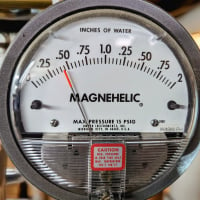What is this in the attic?
I didnt have a ladder tall enough to get into the attic but I noticed this thing that has been up there for at least a half a century. Any clue what it could be?
Thanks in advance.
New England triple decker built around 1900.

"The toes you step on today are connected to the butt you'll have to kiss tomorrow". ---Vincent "Buddy" Cianci
Comments
-
Hi, I think I see two valves, one open and the other closed. Those go to sweat copper 90s (so not too old). In Great Britain they often have a "cistern" in the attic. It fills like a toilet tank and provides a touch of pressure to domestic fixtures in the house. Any chance this is a cistern for potable water in your place and the cold supply to it is closed off? More photos from the other side and above would confirm whether that is a tank or...?
Yours, Larry5 -
In the olden days and 1900 is olden, people cooked with wood or coal stoves. Some of these kitchen stoves had a small water heater built into them and water would circulate thru thermal action from the firebox and heat the small water heater providing hot water at the stove.
Perhaps, there is a tank above the two valves in the attic and hot water would moves from the stove to the attic tank, thru thermal action, and then piped to a faucet somewhere like a bathroom. hmmm
Homer, sounds like a pipe dream! That's what I'm saying, it's all in the piping.1 -
Looks like a domestic water tank. There would be a cistern in the basement that held rainwater which would be pumped up to the attic so there was pressure at the taps. Had a house like this with a beautiful copper tank in the attic in its own closet. This was in Bangor Maine. The pipes went to the fixtures with no insulation just a rough, loose pine enclosure. Nothing was insulated so it never froze in the day. Needless to say, that changed.Tom Gocze1
-
I can't put the pieces together but there is a tap into the chimney. So...0
-
Oh, yeah. Everyone in RI loved "Buddy" hairpiece and all!0
-
Made from scrap wood thrown together and the color of the vertical 2x4 extending from ceiling joist says 1960's. No water tank as the poor framing would not support the weight and wood age suggests something else (In a freezing attic?) Ceiling joist looks cut so whatever was suspended may have connected to the conditioned space below the attic. Looks like a metal chimney flue cap which I'm not sure was part of whatever was suspended.- Could those valves have been gas but no sign of pipes. "Looks to me like a uninsulated balloon-framed triple with outrageous heating costs!!" Most NE states have energy programs like MASS Saves that include insulation incentives- pour in the attic cellulose and dense pack the wall cavities0
-
It may be the remnants of what my Father used to call a “Water Box.” As it was explained to me, it was located in the Attic to provide a “head”…to pressurize the home’s water system and was usually placed very near the Chimney, which allowed a supply line to be snaked up into the Attic easily from the Cellar…in the older houses in Boston there was usually space between the Bricks and the surrounding wood as a Chimney sometimes became somewhat warm and may have been considered a fire hazard? The original Water System that the house was connected to couldn’t always provide an adequate supply so the Box would fill, albeit slowly, and stand ready to supply the house when needed. Furthermore being adjacent to the Chimney chase it directed overflows, etc, to the Cellar which didn’t always work. It was made of Wood and mounted on the side of the Chimney…it was also Lead lined…which might explain why I have an extra finger on my left foot. I digress…the Box’s water level was controlled by a float controlled valve…that occasionally stuck allowing the Box to overflow! I came home from Camp once to find a large piece of Horse Hair Plaster ceiling in my Bed. The House was re-plumbed shortly thereafter!
.2 -
I believe Larry is in the right track here. The cistern tank in the attic was part of the old hot water systems before relief valves and closed tanks. The tank was filled with a valve similar to a toilet ballcock which kept a water level to supply a tank and kerosene coil heater in the basement. The pressure created by the tank in the attic is the highest pressure the system would see. When the hot water expanded, it would flow back into the attic tank. If the system overheated, the same would happen, preventing a rupture of the tank. No Relief valve needed.0
-
It looks like a cistern of some sort, but probably for potable or nonpotable water to store a slow or low or no pressure supply, not dhw. It looks like there is copper or lead sheet warped around the top edge.0
-
No, not a cistern or water box.. Just look at the scrap wood, poor framing, and wood color that tells you none of it original to the house. If it were as many think you would see a very different structure designed to support the weight. It is a flimsy support put up in the 60's to support "something" connected to ceiling as the joists were cut. Where the cut copper pipes go might offer a clue0
-
-
Not sure if it applies here but they used to put hot water heating system expansion tanks in the attics. I just a few months ago removed one and install an extrol tank next to the boiler for a customer doing some remodeling.0
-
-
looks like a cistern for domestic water that came from a source with low flow
0 -
I remember that a cistern was mentioned in that song in the Music Man about "Trouble in River City". Both the Play and the Movie (Matthew Broderick and Robert Preston versions) talked about your children leaving the cistern empty on a Saturday night because of that Mayor's Pool Table. With a capital T that rhymes with P that stands for Pool!!!
Aaah, the modern wonders of indoor plumbing in the 1800s
Edward Young Retired
After you make that expensive repair and you still have the same problem, What will you check next?
0 -
is that zinc sheet lining it?
0 -
Looks like a domestic water roof tank like we have all over the 5 Boros. Gives the building better water pressure via height. I love those old cock valves...Save those. Is that copper-lined too? Mad Dog
0 -
-
I suppose that depends on your perspective. If that is what you're getting automatically from a windmill or something you will make it work.
0 -
-
Hopefully with a little more buffer than 5-10 gallons if that's the case.
You'd want a nice 500 gallon tank for it to feed all night long etc.
Single pipe 392sqft system with an EG-40 rated for 325sqft and it's silent and balanced at all times.
0 -
in modern times. a couple gallons is far better than having to drop a bucket on a rope down a well or work a hand pump.
0 -
The cistern built into my stone foundation is quite large, a rough estimate would be 2000-2500 gallons.
Obviously that's not in the attic, but they pulled from it using a hand pump I assume. My guess is that's how it was done back 150+ years ago.
5-10 gallons just doesn't seem useful unless you're flushing a toilet once.
I vote expansion tank with the others. Though, an ice cold attic with a wide open tank of steamy water seems bad. No?
Single pipe 392sqft system with an EG-40 rated for 325sqft and it's silent and balanced at all times.
0 -
I'm not opposed to it being an expansion tank but the float seems odd for an expansion tank.
The underground cisterns were usually piped in to the basement and largely used for things like laundry.
0 -
Mine was right under the kitchen sink, so my guess was that's what it was used for.
I don't actually know.
I think the float being used as an autofill seems like a good bet, no?
Single pipe 392sqft system with an EG-40 rated for 325sqft and it's silent and balanced at all times.
0 -
Well, for what it's worth it looks exactly like the expansion tanks for the hot water that were common in the UK when I was a kid.
IIRC mains water enters the expansion tank through the float ballcock and then drains into a tank heater.
The expansion tank allows room for expansion of heating water, obviously, but it also creates an air gap preventing the non potable hot water backfeeding into the potable cold side.
Although you can get away with it in the sunny tropics of Britain, it seems like a wildly inappropriate arrangement for an unheated attic in new England. I'm confused about that.
0 -
Based on the size of it, looks to me like the water box from an old pull chain flush toilet.
Dennis Pataki. Former Service Manager and Heating Pump Product Manager for Nash Engineering Company. Phone: 1-888 853 9963
Website: www.nashjenningspumps.com
The first step in solving any problem is TO IDENTIFY THE PROBLEM.1 -
I remember a similar size but modern materials tank for potable water when this old house did a project in the uk 30 or so years ago, I think it was in London.
0 -
Yeah. I changed my mind I think @Pumpguy is the winner!!
0 -
-
-
-
I've seen similar used to supply seal water to liquid ring vacuum pumps on very old installations. This served as an anti-siphon vacuum breaker to prevent back flow of possibly contaminated water to potable supply.
Later a simple air gap funnel fitting was used. Today, Watts and others supply pressure type anti-siphon vacuum breakers for this purpose.
Dennis Pataki. Former Service Manager and Heating Pump Product Manager for Nash Engineering Company. Phone: 1-888 853 9963
Website: www.nashjenningspumps.com
The first step in solving any problem is TO IDENTIFY THE PROBLEM.0 -
-
If this was HWH expansion, and if there was another port we can't see, could it have had 2 pipes connected to the system just like a rad?
That would have induced flow thru the box to keep it from freezing.
The float would keep it topped off, but needs over flow somewhere.
0 -
We had a job with a 300,000 gallon tank outside above ground to store water for sprinklers in a MFG plant. The tank only had 2" of mostly deteriorated foam insulation on it.
They had a boiler that kept it at 45 degrees.
We did a calculation to see how long it would take to freeze when the boiler went our.
It came out to 7 days of 0 deg weather before it would even start to skim over.
Granted the 300,000 tank is many times larger than the attic tank but it take a while to really freeze a solid block.
1
Categories
- All Categories
- 87.3K THE MAIN WALL
- 3.2K A-C, Heat Pumps & Refrigeration
- 61 Biomass
- 429 Carbon Monoxide Awareness
- 120 Chimneys & Flues
- 2.1K Domestic Hot Water
- 5.8K Gas Heating
- 115 Geothermal
- 167 Indoor-Air Quality
- 3.7K Oil Heating
- 77 Pipe Deterioration
- 1K Plumbing
- 6.5K Radiant Heating
- 395 Solar
- 15.7K Strictly Steam
- 3.4K Thermostats and Controls
- 56 Water Quality
- 51 Industry Classes
- 50 Job Opportunities
- 18 Recall Announcements











